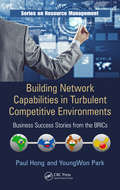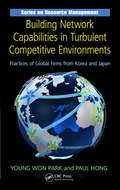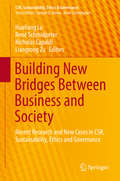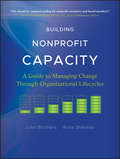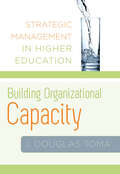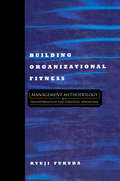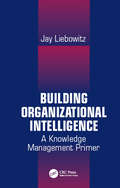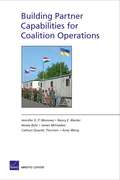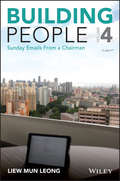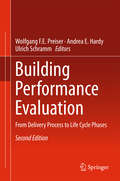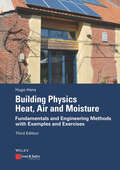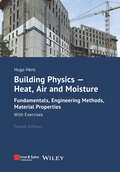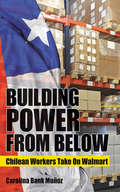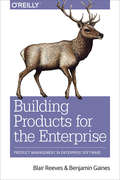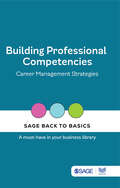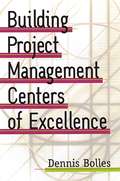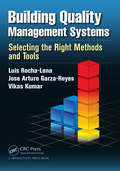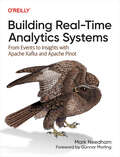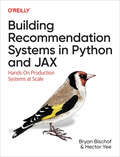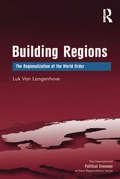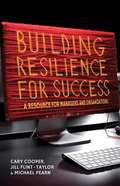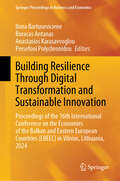- Table View
- List View
Building Network Capabilities in Turbulent Competitive Environments: Business Success Stories from the BRICs (ISSN)
by Paul Hong YoungWon ParkBrazil, Russia, India, and China (BRIC) are among the largest and fastest-growing economies in the world. The enormous size of the customer base in these emerging markets is the strategic concern of global business firms. Successful market performance in these markets requires sound understanding of dynamic environmental factors and timely investme
Building Network Capabilities in Turbulent Competitive Environments: Practices of Global Firms from Korea and Japan (ISSN)
by Young Won Park Paul HongSince the start of the recent financial crisis, as most global firms struggle to remain competitive, an increasing number of Korean and Japanese firms have experienced an amazing rate of growth and expansion. Although academic researchers and business leaders in the United States, China, Brazil, India, and Europe seek out the secrets to these busin
Building Networks That Can Adapt to Risk
by David ApgarIt's a popular myth that business partners get the same results no matter how they allocate risk. But how should your business and personal networks affect the way you think about risk? Part of the solution is to recognize which learnable risks you are likely to understand and track better over time than others can. This chapter proposes a tool, the risk-role matrix, for identifying the ideal role you should play in your risk networks for each of your major risks. Differences in business and personal networks for absorbing certain risks can create lasting advantages and allow you to execute one of the rules of risk intelligence: Keep networks of partners to manage all risks. This chapter is excerpted from "Risk Intelligence: Learning to Manage What We Don't Know."
Building New Bridges Between Business and Society: Recent Research and New Cases in CSR, Sustainability, Ethics and Governance (CSR, Sustainability, Ethics & Governance)
by Nicholas Capaldi René Schmidpeter Hualiang Lu Liangrong ZuThis book provides a comprehensive understanding of the linkages between business and society by addressing key issues in corporate social responsibility (CSR), sustainability, ethics and governance. Thanks to the different visions and perspectives offered by a global group of authors with a broad range of expertise, the book offers a full spectrum of theoretical and practical approaches. Further, it combines the latest theoretical thinking with reviews of frameworks, cases and best practices from various industries and nations. In particular, the book offers a historical perspective on the origins of CSR and discusses CSR in relation to sustainability and management, with a special focus on CSR in Asia.
Building Nonprofit Capacity
by John Brothers Anne ShermanPraise for Building Nonprofit Capacity"A central question for leadership is to identify where, and when, to focus organizational energy, and that is where Brothers and Sherman's book comes in. Changing organizations is never easy, which is why managers need the right set of maps and tools-like this one." Jon Pratt, executive director, Minnesota Council of Nonprofits "Anyone running a nonprofit organization, no matter how large or small, would benefit from reading this book. It's chock-full of useful information about managing change."Eric Nee, managing editor, Stanford Social Innovation Review "Nonprofit leaders need tools to help them manage better, engage communities, collaborate, and have greater impact. Building Nonprofit Capacity is a great tool and a useful reference for organizations that are seeking to make a greater and more sustainable difference." Paul Schmitz, CEO, Public Allies"Brothers and Sherman expertly braid together complementary organizational lifecycle frameworks-and add their own wide-ranging expertise and experience-to bring practitioners and executives this comprehensive, relevant, and honest book about the organizational quest to become ever better."Jeanne Bell, CEO, CompassPoint Nonprofit Services"Whether you are building a start-up, bringing an organization to scale, managing an established group toward excellence, or shepherding a nonprofit at risk of decline, this book should be required reading for every nonprofit executive director." Richard R. Buery, Jr., president and CEO, The Children's Aid Society"There are a lot of nonprofit management books out there. What makes Brothers and Sherman's book different and so important and worthwhile is that they have combined a number of models, theories, and practices and shaped them into a few essential processes that can be used by organizations both large and small."Doug Bauer, executive director, The Clark Foundation"In America, too few nonprofit founders or leaders can afford to step aside, nor have they been taught how to share power in the decision-making process. This critical juncture in the evolution of so many groups is but one reason to buy Building Nonprofit Capacity-a book that will help any forward thinking leader to see the future ? and act, today." Robert Egger, president, DC Central Kitchen"This should be required reading for nonprofit executives and board members!" -Sean Stannard-Stockton, CEO, Tactical Philanthropy Advisors
Building Organizational Capacity: Strategic Management in Higher Education
by J. Douglas TomaEvery university or college president envisions bold initiatives—big projects intended to change the nature of an institution with significant implications across all sectors. How can leaders and senior managers charged with implementing reforms effectively frame their work and anticipate potential pitfalls?No organization can maximize its capacity, defined as the administrative foundation essential for establishing and sustaining initiatives, without considering its core elements individually and in concert, according to J. Douglas Toma. This book examines eight essential organizational elements—purposes, structure, governance, policies, processes, information, infrastructure, and culture—and illuminates their influence in strategic management through case studies at eight institutions.Building Organizational Capacity situates strategic management within the context of higher education, providing practitioners with the tools to better understand institutional challenges in accomplishing its missions and realizing its aspirations. Toma's clear and well-integrated review of the latest research, as well as his advice for decision makers applying the book's lessons in practice, ensures this volume's place in the growing literature on strategy and management in higher education.
Building Organizational Context: Designing an Adaptive Enterprise
by Stephan H. HaeckelFirm's take the first step toward becoming adaptive because old models are no longer sufficient-not because making the transition from a traditional to a sense-and-respond organization is an easy one. By defining the purpose, boundaries, and structure of the adaptive system leaders are striving to create, they will establish the necessary foundation on which a sense-and-respond organization rests. This chapter looks at the three key elements of building a viable design: reason for being, governing principles, and high-level business design.
Building Organizational Fitness: Management Methodology for Transformation and Strategic Advantage
by Ryuji FukudaUndoubtedly, the most urgent task for companies today is to take a hard look at the future. To remain competitive, management must nurture a strong capability for self development and a strong corporate culture, both of which form part of the foundation for improvement. But simply understanding management techniques doesn't mean you know how to use them. You need the tools and technologies for implementation.In Building Organizational Fitness, Ryuji Fukuda extends the power of his managerial engineering methodology into the context of the top management strategic planning role. Published here for the first time, the author provides information on the evolution of his CEDAC methods for use in strategic planning and implementation. The book introduces several key management technologies and describes their successful application in many Japanese, American and European companies, including: P/O (Policy Objective) Matrix, SEDAC (Structure for Enhancing Daily Activities through Creativity), Window Analysis ( a method for classifying and analyzing problem for a view point of management actions required), and Stockless Production (an approach to reduce work-in-process and lead time in an effective and easy-to-understand manner).
Building Organizational Intelligence: A Knowledge Management Primer
by Jay Liebowitz"Sharing knowledge is power." If ever there were a field to which this applies, it is the knowledge management industry. And in today's highly-competitive, fast-paced business world, corporations, businesses and organizations in both the public and private sectors are constantly searching for new cutting-edge methods and techniques for creating, storing, capturing, managing, organizing, distributing, combining, and retrieving knowledge. But the task of accomplishing such functions is not as simple as it sounds. Jay Liebowitz's Building Organizational Intelligence: A Knowledge Management Primer gives executives, managers, systems analysts, and other knowledge-management professionals the competitive edge they need in achieving that task. In a concise and easy-to-read format, the book describes the concepts, techniques, methodologies, and tools associated with those functions, and includes mini-case studies and vignettes of how industry is developing and applying these functions towards building organizational intelligence.What's more, the book is packaged with a limited functionality version of "WisdomBuilder," the first in a family of knowledge-management tools that provide a fully integrated solution to the information management and analysis dilemma. Able to run under Windows 95, 98 and NT, "WisdomBuilder" solves the information overload problem by reducing the time and cost of extracting information and other research knowledge from disorganized repositories of heterogeneous data.
Building Partner Capabilities for Coalition Operations
by Jennifer D. Moroney Cathryn Quantic Thurston James Mcfadden Nancy E. Blacker Renee BuhrOngoing operations and emerging mission requirements place a heavy burden on Army resources, resulting in capability gaps that the Army is unable to fill by itself. One solution is to build the appropriate capabilities in allies and partner armies through focused security cooperation. To do this, Army planners need a more comprehensive understanding of the capability gaps and a process for matching those gaps with candidate partner armies.
Building People: Sunday Emails from a Chairman
by Mun Leong LiewEavesdrop on a top business leader to learn the secrets of great leadership Building People provides a glimpse into the mind of one of Asia's keenest and most effective business leaders. Before becoming Chairman of Changi Airport Group and Surbana Jurong, author Mun Leong Liew was named Best CEO in Singapore, Best CEO in Asia, CEO of the Year, Outstanding CEO of the Year, and more--but his successes are not based strictly upon the numbers. This book reveals the personal and professional philosophy behind this extraordinarily effective leader, in the context of frank and insightful emails to his staff. Touching on everything from honour and potential to training and mentorship, these messages paint a clear picture of the difference between good and great leadership. Effective leaders build companies, but legendary leaders build people--by strengthening the heart of your organisation, you enable robust growth and dynamic stability from the inside out. These emails go beyond mere public relations to lay open the true nature of a man who is honestly, deeply committed to his job, his responsibility, his organisation, and most of all, his people. Learn why work-life balance is not a zero-sum game Discover what pragmatism and commitment truly mean in business Realise the importance of good partnerships and unsung heroes Manage change effectively and employ it wisely for sustainable success By eavesdropping on a leader's communications with the people he serves, you get a real sense of the man behind the success. Great leadership is rooted in a philosophy of "building up" instead of tearing down, and motivated by the sincere belief that we bring our own purpose into everything we do. Building People brings great leadership to life, and inspires action over theory through the insights of Mun Leong Liew.
Building Performance Evaluation: From Delivery Process to Life Cycle Phases
by Wolfgang F.E. Preiser Andrea E. Hardy Ulrich SchrammThe main aim of this book is to present an intriguing retrospective of Building Performance Evaluation (BPE) as it evolved from Post-Occupancy Evaluation (POE) over the past 25 years. On one hand, this is done by updating original authors' chapter content of Building Evaluation, the first edition published in 1989. That, in turn, is augmented by an orientation toward current and future practice on the other, including new authors who are engaged in ongoing, cutting edge projects. Therefore, individual, methodology oriented chapters covering the fundamental principles of POE and BPE go along with major thematic chapters, topics of which like sustainability or integration of new technologies are addressed in a diversity of case studies from around the globe. Research, methodologies, and framework of POEs continue to evolve. POEs are one step, on the larger scale of BPE, in understanding how buildings function after they are occupied. This resource helps a rchitects, building owners, and facility managers understand the implications and reactions to the facilities that they designed, built and/or commissioned. By considering the whole process from conception to future uses of the building, there can be a more holistic approach to the planning, programming, design, construction, occupancy, and future adaptability of the structure. This book is dedicated to first editor Wolfgang F. E. Preiser who passed away during the process of editing and reviewing chapters of this volume.
Building Physics - Heat, Air and Moisture: Fundamentals and Engineering Methods with Examples and Exercises
by Hugo S. HensBad experiences with construction quality, the energy crises of 1973 and 1979, complaints about "sick buildings", thermal, acoustical, visual and olfactory discomfort, the need for good air quality, the move towards more sustainability - all these have accelerated the development of a field that, for a long time, was hardly more than an academic exercise: building physics (in English speaking countries sometimes referred to as building science). The discipline embraces domains such as heat and mass transfer, building acoustics, lighting, indoor environmental quality and energy efficiency. In some countries, fire safety is also included. Through the application of physical knowledge and its combination with information coming from other disciplines, the field helps to understand the physical phenomena governing building parts, building envelope, whole buildings and built environment performance, although for the last the wording "urban physics" is used. Today, building physics has become a key player on the road to a performance based building design. The book deals with the description, analysis and modeling of heat, air and moisture transport in building assemblies and whole buildings with main emphasis on the building engineering applications, including examples. The physical transport processes determine the performance of the building envelope and may influence the serviceability of the structure and the whole building. Compared to the second edition, in this third edition the text has partially been revised and extended.
Building Physics - Heat, Air and Moisture: Fundamentals, Engineering Methods, Material Properties and Exercises
by Hugo S. HensBad experiences with construction quality, the energy crises of 1973 and 1979, complaints about "sick buildings", thermal, acoustical, visual and olfactory discomfort, the need for good air quality, the move towards energy efficiency, decarbonization and sustainability ? all these have accelerated the development of a discipline that, for a long time, was hardly more than an academic exercise: building physics. The discipline embraces domains such as heat and mass transfer, building acoustics, lighting, indoor environmental quality, energy efficiency, and, in some countries, fire safety. Through the application of physical knowledge and its combination with information coming from other disciplines, building physics helps to under-stand the physical phenomena governing building parts, building envelope, whole building and built environment performance ? called urban physics. Today, building physics has be-come a key player on the road to highly performing new buildings and renovations. This book deals with heat, air and moisture transport in building parts or assemblies and whole buildings with emphasis on the building engineering applications. Compared to the third edition, this fourth edition has been expanded in chapter 1 to include the physical determination of the thermal conductivity of materials, together with an in-depth discussion of all the effects of thicker insulation layers. In chapter 2, additional information has been added on wind pressure and the evaluation of condensation inside the building com-ponents, while a new chapter 4 on material properties has been included. The whole book, including the figures, has been revised and restructured where necessary.
Building Power from Below: Chilean Workers Take On Walmart
by Carolina Bank MuñozA story that involves as its main players "workers" and "Walmart" does not usually have a happy ending for labor, so the counternarrative offered by Building Power from Below is must reading for activists and union personnel as well as scholars. In 2008 Walmart acquired a controlling share in a large supermarket chain in Santiago, Chile. As part of the deal Walmart had to accept the unions that were already in place. Since then, Chilean retail and warehouse workers have done something that has seemed impossible for labor in the United States: they have organized even more successful unions and negotiated unprecedented contracts with Walmart.In Building Power from Below, Carolina Bank Muñoz attributes Chilean workers’ success in challenging the world’s largest corporation to their organizations’ commitment to union democracy and building strategic capacity. Chilean workers have spent years building grassroots organizations committed to principles of union democracy. Retail workers’ unions have less structural power, but have significant associational and symbolic power. Their most notable successes have been in fighting for respect and dignity on the job. Warehouse workers by contrast have substantial structural power and have achieved significant economic gains. While the model in Chile cannot necessarily be reproduced in different countries, we can gain insights from the Chilean workers’ approaches, tactics, and strategies.
Building Products for the Enterprise: Product Management in Enterprise Software
by Blair Reeves Benjamin GainesIf you’re new to software product management or just want to learn more about it, there’s plenty of advice available—but most of it is geared toward consumer products. Creating high-quality software for the enterprise involves a much different set of challenges. In this practical book, two expert product managers provide straightforward guidance for people looking to join the thriving enterprise market.Authors Blair Reeves and Benjamin Gaines explain critical differences between enterprise and consumer products, and deliver strategies for overcoming challenges when building for the enterprise. You’ll learn how to cultivate knowledge of your organization, the products you build, and the industry you serve.Explore why:Identifying customer vs user problems is an enterprise project manager’s main challengeEffective collaboration requires in-depth knowledge of the organizationAnalyzing data is key to understanding why users buy and retain your productHaving experience in the industry you’re building products for is valuableProduct longevity depends on knowing where the industry is headed
Building Professional Competencies: Career Management Strategies (SAGE Back to Basics)
by SAGE Publications India Pvt. LtdEvery single one of the competencies discussed in this book can lead you to your next promotion or that extra bonus. The book shows how to nurture a few essential professional competencies such as creating an outstanding presentation, public speaking, effectively communicating your opinions and ideas, and becoming a credible and reliable team player. Building Professional Competencies is a call for action to become a competent player in today’s workforce. SAGE Back to Basics is a distilled compilation of proven and timeless ideas and best practices for new-age and experienced leaders alike. The hand-picked collection of books—on management, leadership, entrepreneurship, branding and CSR—offer advice from management experts whose knowledge and research has impacted and shaped business and management education Other books in the series: Timeless Leadership | Advertising and Branding Basics | Leadership Lessons from Dr Pritam Singh | Corporate Social Responsibility in India | Basics of Entrepreneurship | Human Resource Development Insights | Ideate, Brainstorm, Create | Timeless Management | Soft Skills for Workplace Success
Building Project-Management Centers of Excellence
by Dennis BollesIt&’s been shown again and again that business components from R & D to systems, engineering to manufacturing can benefit from a project-centered management approach. Now, organizations that have had success at the departmental or divisional level are taking the project management approach to new levels, adopting PM standards into across-the-board management philosophies and business strategies. This new model is known as the Project Management Center of Excellence. PMCoEs need every group within the organization to work under the PM model, but more important, they need the proper tools to implement PM standards in new areas. A crucial tool in developing project management objectives across the company, this book covers: * Positioning project management as a business strategy * Creating and managing an organizational PM portfolio * Education, training, and internal PM certification programs * Classifying projects, benchmarking, and mapping a methodology
Building Quality Management Systems: Selecting The Right Methods And Tools
by Vikas Kumar Luis Rocha-Lona Jose Arturo Garza-ReyesQuality has quickly become one of the most important decision-making factors for consumers. And although organizations invest considerable resources into building the right quality management systems (QMSs), in many instances, the adoption of such quality improvement tools are just not enough. Building Quality Management Systems: Selecting the Right Methods and Tools explains exactly what directors, practitioners, consultants, and researchers must do to make better choices in the design, implementation, and improvement of their QMSs. Based on the authors’ decades of industrial experience working on business improvement projects for multinationals looking to design or improve their QMSs, the book discusses building QMSs based on two important organizational elements: needs and resources. It begins with an overview of QMSs and systems thinking and the impact of QMSs on financial performance. Illustrating the process management approach, it reviews the most well-known business and quality improvement models, methods, and tools that support a major QMS.
Building Quality Management Systems: Selecting the Right Methods and Tools
by Vikas Kumar Jose Arturo Garza-Reyes Luis Rocha-LonaQuality has quickly become one of the most important decision-making factors for consumers. And although organizations invest considerable resources into building the right quality management systems (QMSs), in many instances, the adoption of such quality improvement tools are just not enough. Building Quality Management Systems: Selecting the Righ
Building Real-Time Analytics Systems: From Events to Insights with Apache Kafka and Apache Pinot
by Mark NeedhamGain deep insight into real-time analytics, including the features of these systems and the problems they solve. With this practical book, data engineers at organizations that use event-processing systems such as Kafka, Google Pub/Sub, and AWS Kinesis will learn how to analyze data streams in real time. The faster you derive insights, the quicker you can spot changes in your business and act accordingly.Author Mark Needham from StarTree provides an overview of the real-time analytics space and an understanding of what goes into building real-time applications. The book's second part offers a series of hands-on tutorials that show you how to combine multiple software products to build real-time analytics applications for an imaginary pizza delivery service.You will:Learn common architectures for real-time analyticsDiscover how event processing differs from real-time analyticsIngest event data from Apache Kafka into Apache PinotCombine event streams with OLTP data using Debezium and Kafka StreamsWrite real-time queries against event data stored in Apache PinotBuild a real-time dashboard and order tracking appLearn how Uber, Stripe, and Just Eat use real-time analytics
Building Recommendation Systems in Python and JAX: Hands-On Production Systems at Scale
by Bryan Bischof Hector YeeImplementing and designing systems that make suggestions to users are among the most popular and essential machine learning applications available. Whether you want customers to find the most appealing items at your online store, videos to enrich and entertain them, or news they need to know, recommendation systems (RecSys) provide the way.In this practical book, authors Bryan Bischof and Hector Yee illustrate the core concepts and examples to help you create a RecSys for any industry or scale. You'll learn the math, ideas, and implementation details you need to succeed. This book includes the RecSys platform components, relevant MLOps tools in your stack, plus code examples and helpful suggestions in PySpark, SparkSQL, FastAPI, and Weights & Biases.You'll learn:The data essential for building a RecSysHow to frame your data and business as a RecSys problemWays to evaluate models appropriate for your systemMethods to implement, train, test, and deploy the model you chooseMetrics you need to track to ensure your system is working as plannedHow to improve your system as you learn more about your users, products, and business case
Building Regions: The Regionalization of the World Order (The International Political Economy of New Regionalisms Series)
by Luk Van LangenhoveRegions. How they emerge and how they are dramatically changing the appearance of the present 'world of states' and its related forms of governance from local to global levels is analysed in this monograph. But what are regions? Regions can be small or huge. They can be part of a single state, be composed out of different states or stretched out across borders. They can be important recognized economic, social or cultural entities or they can be largely ignored by the people who live on a region's territory. They can be well-defined with clear cut boundaries as is the case in so-called 'constitutional regions' or they can be fuzzy as for instance in cross-border regions. In sum, they are not a natural kind and defining regions is not a simple task. Luk Van Langenhove advances the concept of region building as an alternative to the construction of regions with three issues of region building being explored: - Why are regions built in a world of states? - How do region building processes take place? - How are regions transforming the present world order? Crossing disciplinary boundaries, this book is an exercise in theorizing regions and brings together under one conceptual framework, different processes and concepts such as regional integration, devolution, federalism, and separatism and refines the social constructionist view on regions
Building Resilience For Success
by Cary L. Cooper Jill Flint-Taylor Michael PearnResilience is a word that is used in many different ways in different contexts, this new and innovative book focuses on psychological resilience in the workplace, examining other key aspects such as physical health and resilient teams, drawing from the latest research and the authors own practical experience.
Building Resilience Through Digital Transformation and Sustainable Innovation: Proceedings of the 16th International Conference on the Economies of the Balkan and Eastern European Countries (EBEEC) in Vilnius, Lithuania, 2024 (Springer Proceedings in Business and Economics)
by Anastasios Karasavvoglou Persefoni Polychronidou Ilona Bartuseviciene Buracas AntanasThis volume brings together a selection of papers presented at the International Conference "Economies of the Balkan and Eastern European Countries" (EBEEC), held at Mykolas Romeris University, Vilnius, Lithuania, on May 17–19, 2024. The book explores strategies for overcoming global challenges across diverse sectors and regions, emphasizing the imperative for resilient, sustainable, and digitally driven economic transitions. Moving beyond traditional metrics of efficiency and productivity, it underscores the need for globally competitive frameworks that balance innovation, environmental responsibility, and adaptability. The contributions provide fresh perspectives on economic security and resilience, highlighting sustainability-focused innovations that promote environmental stewardship across industries. They also examine the transformative impact of digital technologies and artificial intelligence on consumer behavior, education, business practices, and societal acceptance or resistance in dynamic economies. By presenting a range of analytical frameworks, this book equips readers with actionable insights into fostering transformative capabilities. It serves as a critical resource for navigating the complexities of local and global economic landscapes, enabling stakeholders to skillfully manage uncertainty and drive meaningful progress.
